BY HENRY SHEEHAN
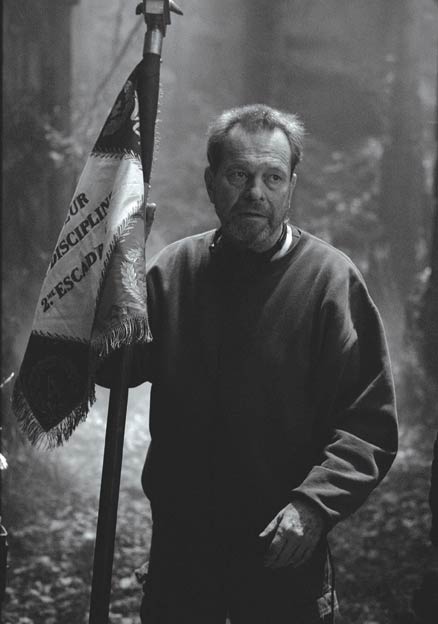 Terry Gilliam had already directed a handful of critical and box office successes with his Monty Python mates (Monty Python and the Holy Grail, Time Bandits) when he finally got the go-ahead to make his dream project, Brazil, in 1985. After it was finished, Universal was poised to release a severely cut version when the Los Angeles Film Critics Association “rescued” the movie by voting it Best Picture of the Year—before it was even in theaters.
Terry Gilliam had already directed a handful of critical and box office successes with his Monty Python mates (Monty Python and the Holy Grail, Time Bandits) when he finally got the go-ahead to make his dream project, Brazil, in 1985. After it was finished, Universal was poised to release a severely cut version when the Los Angeles Film Critics Association “rescued” the movie by voting it Best Picture of the Year—before it was even in theaters.
Gilliam couldn’t have perceived the shape of things to come when he finally got behind the camera to shoot the Tom Stoppard-Charles McKeown script. And though his film would eventually be hailed as groundbreaking and visionary, Gilliam was actually doing what he nearly always did: whipping up fantasy from commonplace materials and cottage craftsmanship, like the cutout animations from his Monty Python years. Brazil’s production backstory would resemble the world it depicted, a precisely conceived alternate universe, part post-war Britain and part Orwellian nightmare.
Gilliam’s approach to making Brazil recalls Orson Welles’ description of a movie studio as “the biggest train set a boy ever had.” But unlike Welles, Gilliam was not a profligate, careless spender (he made the film for an almost unbelievable $14 million). As his comments suggest, his method was inherently frugal, inevitably tending towards the inexpensive and handmade rather than the high-tech.
Even in his remarks 20 years later, Gilliam seems to delight in the inventiveness and sheer fun of it all. The scene he describes here is the imminent torture of his hero (Jonathan Pryce) right before he is rescued by a squadron of commandoes led by Robert De Niro.
Looking at it now, you can’t blame people for thinking the strange, hypnotic Brazil was the result of state-of-the-art cinematic chicanery. As Gilliam says of the final result, “There’s no question it’s different stuff than people get with their daily corn flakes in the morning.
Everything we did in the film was exaggerated, so for a padded cell this was the most comfy cell ever made. We over-padded the walls. Looking down it’s probably a 9.8 mm lens. I was in love with this lens at that point. It was the first really wide-angle lens that didn’t fish-eye. But it did bend a bit around the edges, so we had to be careful how we used it. So we built a set and we probably made it taller than it should be just to get the high-angle shot looking down to make Jonathan seem tiny in the corner.
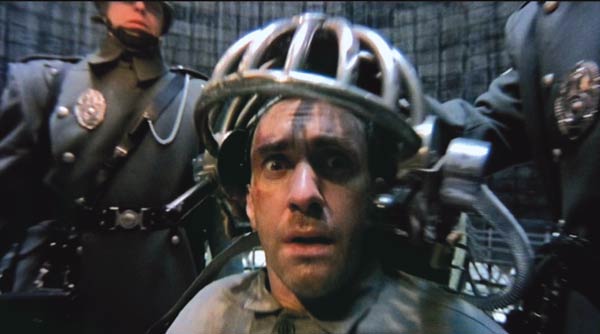
This is a really interesting shot. It starts on Jonathan and the bag is taken off his head and reveals his face, then a fast pull-back reveals the entire torture chamber–which was the inside of a cooling tower of a disused power plant in the south of London. To do this thing fast enough, we shot at four frames per second. So the actors had to act six times slower than normal. To make it more complicated, the platform that Jonathan is on is about 35 feet above the ground and the spokes radiating out of it are only about eight inches maximum. There was nothing to stop us falling off the edge.
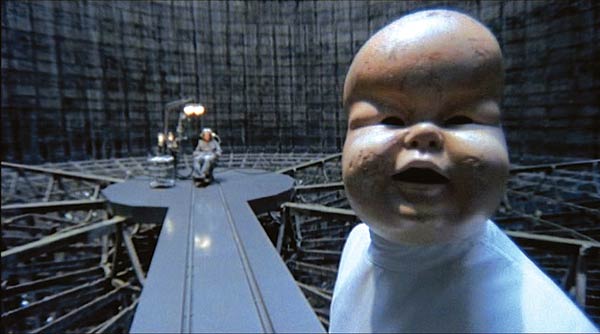
In this shot, with Michael Palin in the doll’s head in the foreground, you can see tracks on the floor. We built the center platform and then a long walkway to it, knowing we were going to do the pull-back shot and so actually incorporated the tracks as part of the set. Everybody was involved trying to push this thing. The difficult part was stopping it as we were about to hit the wall. So much of Brazil was done in this rather primitive hand-drawn fashion. What we intended was this whoosh, this gasp as the space is revealed. It worked. I think people were kind of amazed.
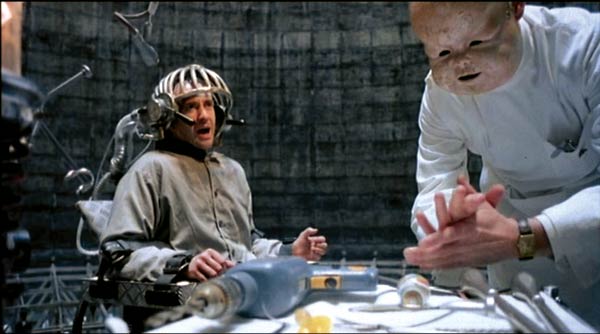
What was interesting about this shot were the objects we put on the table as the potential torture appliances. There’s a Black & Decker drill, a baby’s pacifier and a couple of toys; clearly the doctor’s daughter has been playing out there. It was to create the idea that somehow children were out there in between his ‘jobs.’ Because of the curving effect at the lens’ edges, actors would appear bent over backward if they were at the edges of the frame.
When Palin gets shot there was a squib already in the mask; the trick was to blow the squib and then he pulls the mask off to show his bloodied face. The only difficulty with any of this was this very, very small space we had to work on. At any moment there were probably eight people out there. The strange thing about this mask was that it was actually a copy of a rotting doll’s head that I discovered by chance in my parents’ garden one day. It was this weird mixture of a doll and a Buddha—yet it’s covering terrible violence.
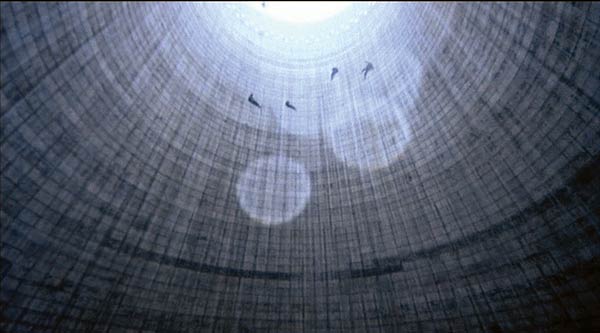
We lit the set by having this gigantic crane outside the tower—because those cooling towers are open at the top—and a big light hanging up there. We used that to rig the stunt. At one point we were talking about doing that as an effect. But the stunt coordinator convinced me that they could actually do it. The guys got on there and just rappelled down. With CG and everything, people now would do it with computers. But there’s something about that space and the reality of it—because it’s all in one shot coming down—that’s just real.
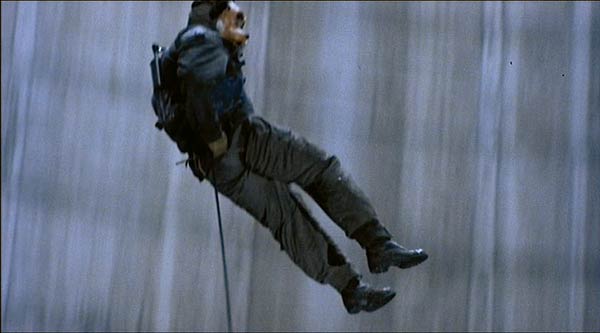
What was extraordinary when they came down, they hit those little spokes, eight inches across at the most, with these silly masks on and ran across those with no safety. There was no safety at all involved in this. You couldn’t get away with that now, but the stuntmen were determined to show they could do it. I was terrified as it was happening because all it would take was one misstep; they were trying to see through the eye holes of masks and they’re firing guns at the same time. We did it in one take. I couldn’t believe what we were getting, because I didn’t expect as much.
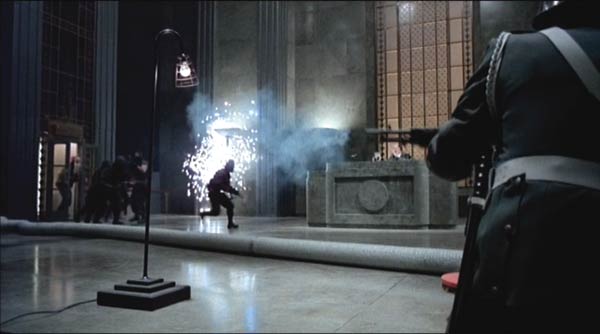
To have a bunch of commandoes trapped in an elevator [left] trying to get into the action, that to me was an absurd thing. That stage was probably only about 120 feet by 80 feet. Again, the wide-angle lenses were making it look big. It’s a tricky thing working with wide angles because I didn’t want it to look like pop videos or horror films where you’re pushing the camera into people’s faces. There are a lot of directors who just get so excited by the fact they can blow up things and shoot people and all that. It doesn’t get my juices going the way ideas get my juices flowing.
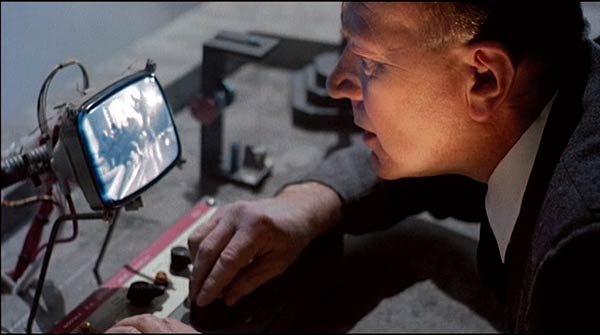
I was always drawing in these little jokes. Like the receptionist playing a video game of these guys as they were blowing up. Looking around, I could see the beginnings of video games. Reality is getting really twisted at this point. Those little screens—they were already there on the desk and I just decided at the last moment, ‘OK, let’s do it.’ It was another way of trying to deal with my obsession with violence, particularly in television and movies and games. I thought, ‘let’s have a really horrible game.’ I did at every point want to satirize action films and battles and things like that.
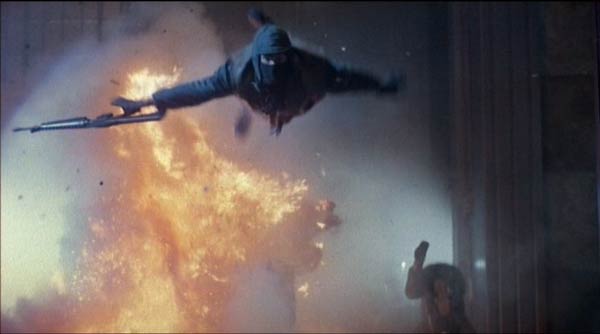
I don’t find these shots difficult at all. People go on too much about action being difficult. It isn’t. If you’ve got a good effects team and a good stunt team, that’s the work. So you have a guy flying through the air; the way it was done was on a little trampoline. He jumped off a box, hit that, flew through the air and everybody got the timing right so the explosion went off as he went through the air. It’s very crude; we weren’t using wires or that stuff at all. It was just what you can do on the floor fairly quickly.
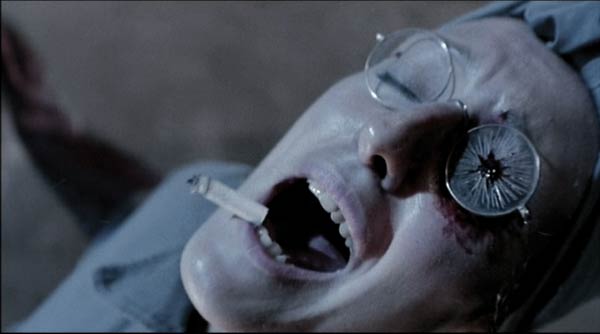
This is kind of a joke in the midst of all the mayhem—the heroic cleaning woman being shot. It’s a shot from Potemkin just thrown in for film buffs, because the vast majority of people have no idea what it is. After having spent years writing the script, I found that as I got closer to the actual business of shooting I had to start entertaining myself with new ideas. So this was a nerdy element—including shots of the troops marching relentlessly down the stairs like in Potemkin.
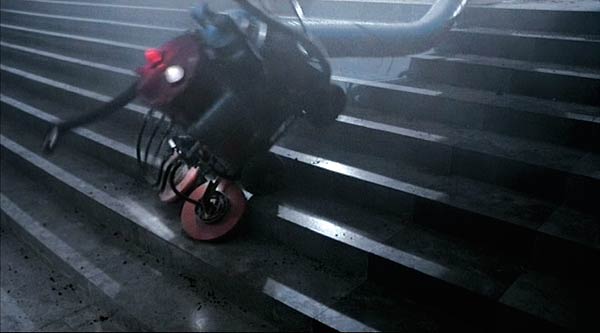
I’ve always been obsessed with the people—this was very much part of what Brazil was about—like the De Niro character, who was a plumber. It’s all the people behind the scenes that keep the system going. So, again, I was kind of obsessed with cleaning ladies. So in the middle of this battle, I just thought I’d put somebody in there who was so focused on their job that they paid no attention to what was going on. We needed a moment to have her shot and then the cleaning machine go trundling down the steps like in Potemkin.
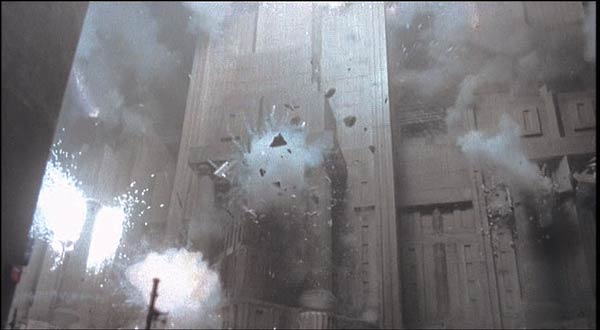
We built two miniatures about 20 feet high. There were four or five cameras going, all working at various speeds, overcranked considerably. I always find it difficult working with multiple cameras because I’ve only got one real shot in my head most of the time. Two cameras I can handle, but beyond that I get into this thing, ‘Well, what’s there to shoot?’ All we could afford was two goes at the thing. The first one was actually a disaster, a whole section didn’t blow properly.
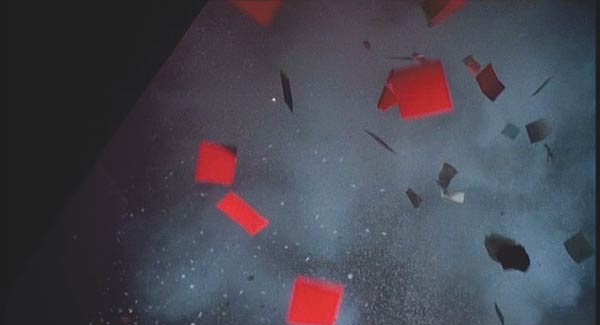
The cataclysm and the catharsis of an explosion; that's what the story was demanding. It was a world completely crushed by paperwork and bureaucracy. Then when that stuff comes floating down, it's joyous. You blow paper in the air, light it and it floats down. We slammed red light on it and it looked fantastic. There's a lot of smoke in the air that's lit, then silhouetted paper, then as it comes close to the camera, the red light kicks in; so you've got three layers of it. You light-and surprise, surprise-it looks beautiful.